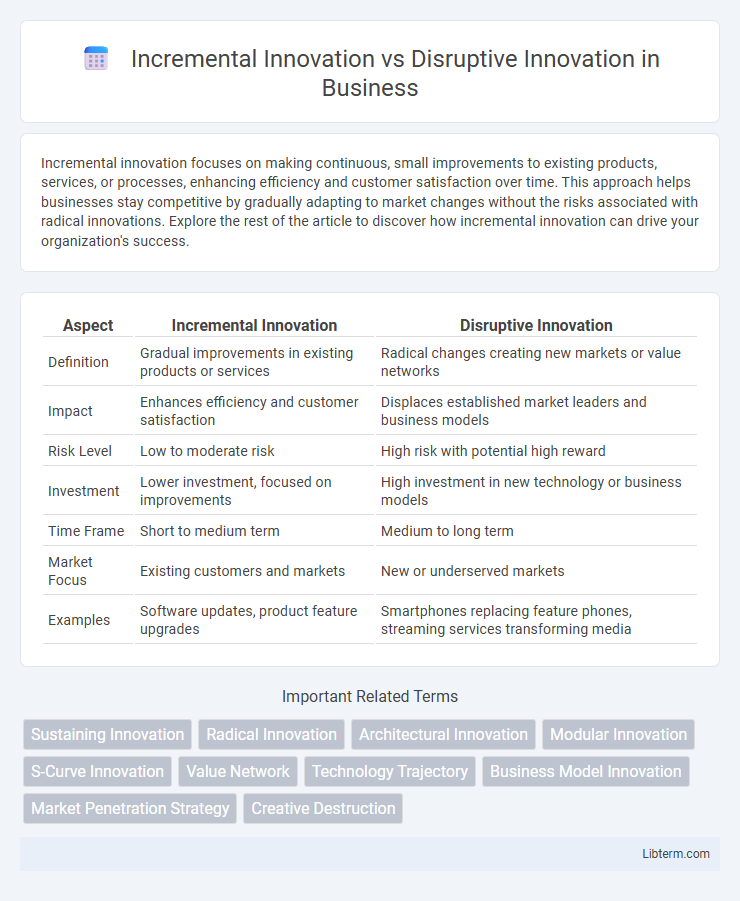Incremental innovation focuses on making continuous, small improvements to existing products, services, or processes, enhancing efficiency and customer satisfaction over time. This approach helps businesses stay competitive by gradually adapting to market changes without the risks associated with radical innovations. Explore the rest of the article to discover how incremental innovation can drive your organization's success.
Table of Comparison
| Aspect | Incremental Innovation | Disruptive Innovation |
|---|---|---|
| Definition | Gradual improvements in existing products or services | Radical changes creating new markets or value networks |
| Impact | Enhances efficiency and customer satisfaction | Displaces established market leaders and business models |
| Risk Level | Low to moderate risk | High risk with potential high reward |
| Investment | Lower investment, focused on improvements | High investment in new technology or business models |
| Time Frame | Short to medium term | Medium to long term |
| Market Focus | Existing customers and markets | New or underserved markets |
| Examples | Software updates, product feature upgrades | Smartphones replacing feature phones, streaming services transforming media |
Understanding Incremental Innovation
Incremental innovation involves making continuous improvements to existing products, services, or processes, enhancing performance, efficiency, or value without altering the core framework. This type of innovation is crucial for maintaining competitive advantage by addressing customer feedback and evolving market needs through small, manageable changes. Companies leveraging incremental innovation benefit from reduced risk and steady growth, ensuring product relevance and improved user satisfaction over time.
Defining Disruptive Innovation
Disruptive innovation refers to a process where a new product or service initially targets a niche market or underserved segment, eventually displacing established competitors by offering simpler, more affordable, or more convenient solutions. Unlike incremental innovation, which improves existing products or services through gradual enhancements, disruptive innovation transforms industries by creating entirely new value networks. The concept, popularized by Clayton Christensen, emphasizes how startups or small entrants can challenge dominant market players through innovative business models and technologies.
Key Differences Between Incremental and Disruptive Innovation
Incremental innovation involves gradual improvements to existing products or processes, enhancing performance and efficiency without drastically changing market dynamics. Disruptive innovation introduces groundbreaking changes that create new markets or significantly alter existing ones, often displacing established technologies and business models. Key differences include the scope of impact, with incremental innovation targeting optimization within current frameworks, while disruptive innovation redefines market landscapes and consumer behavior.
Advantages of Incremental Innovation
Incremental innovation offers advantages such as lower risk and cost compared to disruptive innovation, enabling businesses to improve existing products and processes steadily. It fosters continuous enhancement and customer satisfaction by refining features and addressing user feedback without major market upheaval. This approach supports sustainable growth and strengthens competitive advantage through gradual improvements aligned with established market demands.
Benefits of Disruptive Innovation
Disruptive innovation drives transformative change by creating new markets and value networks, often displacing established industry leaders. It fosters significant competitive advantages through breakthrough technologies or business models that meet previously unmet customer needs. Companies embracing disruptive innovation benefit from early market entry, increased customer loyalty, and long-term growth opportunities.
Challenges Associated with Each Innovation Type
Incremental innovation faces challenges such as limited market impact, resistance to change within established organizations, and difficulty in maintaining competitive advantage due to modest improvements. Disruptive innovation encounters obstacles including high uncertainty, significant resource investment, and potential market resistance from incumbents unwilling to adopt radically new technologies. Both types demand distinct risk management strategies, with incremental innovation struggling to achieve breakthrough differentiation and disruptive innovation requiring navigation through resistance and market volatility.
Real-World Examples of Incremental Innovation
Incremental innovation is evident in Apple's successive iPhone models, where each version introduces improved features such as enhanced cameras, better battery life, and refined software without radically changing the core product. Toyota's continuous refinement of hybrid technology in the Prius demonstrates incremental innovation by steadily enhancing fuel efficiency and reducing emissions over multiple generations. These real-world examples showcase how companies leverage small, consistent advancements to maintain competitive advantage and meet evolving customer needs.
Case Studies of Disruptive Innovation
Disruptive innovation fundamentally reshapes markets by introducing groundbreaking products or services that create new value networks, as exemplified by Netflix's transformation of the entertainment industry through streaming technology. Airbnb disrupted traditional hospitality by leveraging peer-to-peer sharing platforms, enabling scalable lodging options beyond hotels and reshaping travel accommodation. Tesla's development of electric vehicles combined with a direct sales model disrupted the automotive sector by accelerating the shift to sustainable transportation and challenging legacy manufacturers.
Choosing the Right Innovation Strategy for Your Business
Choosing the right innovation strategy depends on your business goals, market position, and risk tolerance. Incremental innovation enhances existing products or processes, offering steady growth and lower risk, ideal for established companies seeking continuous improvement. Disruptive innovation introduces breakthrough changes that redefine markets, suitable for startups or businesses aiming to capture new customer segments and achieve rapid growth.
Future Trends in Incremental and Disruptive Innovation
Future trends in incremental innovation emphasize continuous improvements in existing technologies, leveraging AI and data analytics to optimize product performance and customer experience. Disruptive innovation is increasingly driven by breakthroughs in quantum computing, biotechnology, and sustainable energy solutions, creating entirely new markets and transforming industries. Both innovation types benefit from growing investment in digital platforms and cross-industry collaborations accelerating adoption and scalability.
Incremental Innovation Infographic

 libterm.com
libterm.com